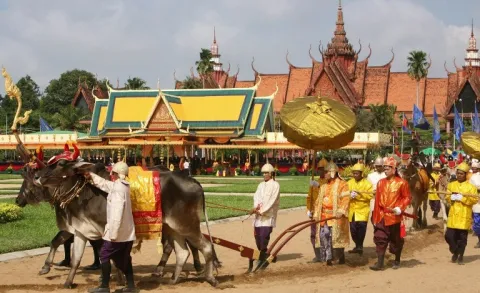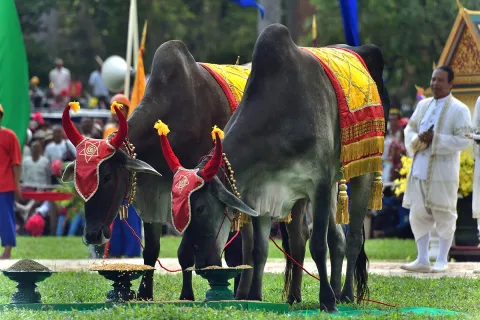Located 40km north of Phnom Penh on the west bank of the Tonle Sap River at the confluence of Kandal, Kampong Chhnang, and Kampong Speu is the historical area of Longvek-Oudong that was home to Cambodia’s capital in periods of the 16th century to the mid-19th century long after leaving Angkor. It was a period of great prosperity with the opening to international trade, and, a time of great conflict, war, and power struggles.
It’s an amazing area that we can explore, with heritage sites spread out over a 60 sq km area including Buddhist Terraces, heritage pagodas, shrines, and, of course, the epic mountain of Phnom Oudong with its grand stupa and shrines.
Let’s put it all together on a map, discover the highlights in the area, and take a dive into history. At the bottom of the page, I’ll also include a section on historical images and a summary of notes that were left by the Dutch and French in the 16th-19th century featuring some quite fascinating insights on the era.
Historical Intro to the Longvek & Oudong Eras
Exploring the historical notes left by the Dutch, French, and the contemporary translations of the Royal Chronicles we can build a little bit of a backstory to the area, or an outline at least. The numerous sources mentioned often have conflicting dates, something that will likely be qualified and expanded on by continuing research and archeological work in the area. For now, let’s begin that backstory after the capital had shifted from Angkor to the ever-prosperous Mekong, southeast of the Tonle Sap.
Around the 15th century, the capital of Cambodia had shifted south to the Srei Santhor area, and later to Chaktomuk (Present day Phnom Penh), and around the beginning of the 16th century, the nation would enter a civil war seeing Sdech Khan and Ang Chan at loggerheads for a decade, with Sdech Khan occupying east of the Mekong and Chan to the west. Ang Chan would eventually be victorious, uniting the nation and shifting his base from Pursat to establish a new capital at Longvek. This site had prior heritage in the 7th century, noting inscriptions and artifacts discovered there, and may have already been an active maritime area.
Before the completion of his new citadel, he would lay waste to invading forces from Siam at Angkor and later begin notable restorations at Angkor Wat and the clearing of the Bayon temple. It was at this time the first reports of Europeans in the country emerged. King Ang Chan would reside at a citadel in Banteay Meanchey, and then the Citadel of Baribaur (Kampong Chhnang) before returning to his newly constructed citadel at Longvek.
Longvek would be centred around a massive earthen-walled citadel with a cross-shaped Wat Tralaen Kaeng at its centre, located north of the mountain of Oudong and west of the Tonle Sap River. At that time, a grand statue of the four-sided Buddha was commissioned and placed at Wat Traleang Kaeng, a sandstone statue whose feet can still be seen in the pagoda today. Wat Preah En Tep was also constructed along with constructions atop Phnom Oudong including Wat Athross and its giant Buddha along with what we call today Buddha Nirvana, the sandstone statue of the reclining Buddha and his attendants. He also commissioned an iron smelter tended by the famed Kouy metal workers and two basins at the foot of the mountain. The great king would pass away in the mid-late 16th century (1567) with his remains enshrined in the stupa that fronts the Buddha Nirvana.
By all reports, it was a prosperous time for trade across South East Asia, and it would be around this time, that Portuguese and Spanish missionaries would visit Cambodia and leave with us the first European reports of Cambodia earlier reports were noted in Chinese annals of diplomatic missions, likewise with Japan. Cambodia was noted for gold, silver, copper, iron, brass, tin, silk, benzoin (tree sap), lac (an insect used to create red dye), wax, ivory, rhinoceros horns, elephants, and horses, some notes also mention Aloewood (agarwood), other notes mention Cambodia being an important source of dried ginger for Chinese traders.
In the later stages of the 16th century, the Khmer would be fighting off invasions from Laos and Siam, but both were unsuccessful. After a period of peace, Siam would wage an unsuccessful attack on Longvek, later to be followed by a second attack in which Siam assembled its largest-ever army to attack. The Khmer king, Satha, would enlist the help of the Portugues and Spanish already in Cambodia at that time, with requests sent to the Spanish governor in the Philippines to send help. That help would come too late. King Satha escaped to the east preceding the attack, later heading north to Laos or at least Sambour (also see Wat Sasar Muoy Roy) and in the end, Siam forces would take the remaining royal court and reportedly, over 100,000 people back to Ayutthaya, along with the nation’s treasures, literature, and leaving nothing but ruin.
From the ruins, a young Cambodian prince would rise and raise an army once again and demolish the remaining Siamese forces that had burnt Longvek to the ground. The Royal Court returned to Srey Santhor where it remained for two decades or more, in a turbulent state that saw six different kings come and go.
In the early 17th century, King Chey Chetta II established a new capital at Oudong and it would be in the mid-17th century that the adventures and misadventures of the Dutch East India Company would begin adding to the established presence of Chinese, Malays, Portuguese, and Japanese in the contexts of trade, missionaries, and pilgrimage.
During this time, the Oudong Era would last from the 17th century to the 19th century and Cambodia would see the throne change 23 times including the rise of a Queen to the throne, Queen Ang Mey, and the change of the state religion to Islam under the reign of Ramathipadi I (Ponhea Chan/Sultan Ibrahim) from 1642–1658 (also note the inscribed tablet this king left at Phnom Bakheng), and finally the rise of King Ang Doung.
In the 19th century, King Ang Doung united the country at a very difficult time, ushering in a foundation for a new age of prosperity and stability. King Ang Doung is one of the highly regarded kings of the era, leaving an enormous legacy not only in pivoting Cambodia out of difficult times, but also a legacy in art, culture, and civil reform. He established his royal court at what we know today as Wat Veang Chas and also constructed Wat Prang. Near Kampong Luong, a contemporary statue of Ang Doung atop his horse can be seen which is somewhat poetically surrounded by sandstone markers that may have once lined the beautiful roadway to his palace as noted by French reports. Around 1866, he moved the capital and Royal Palace to Phnom Penh where it resides to this day.



